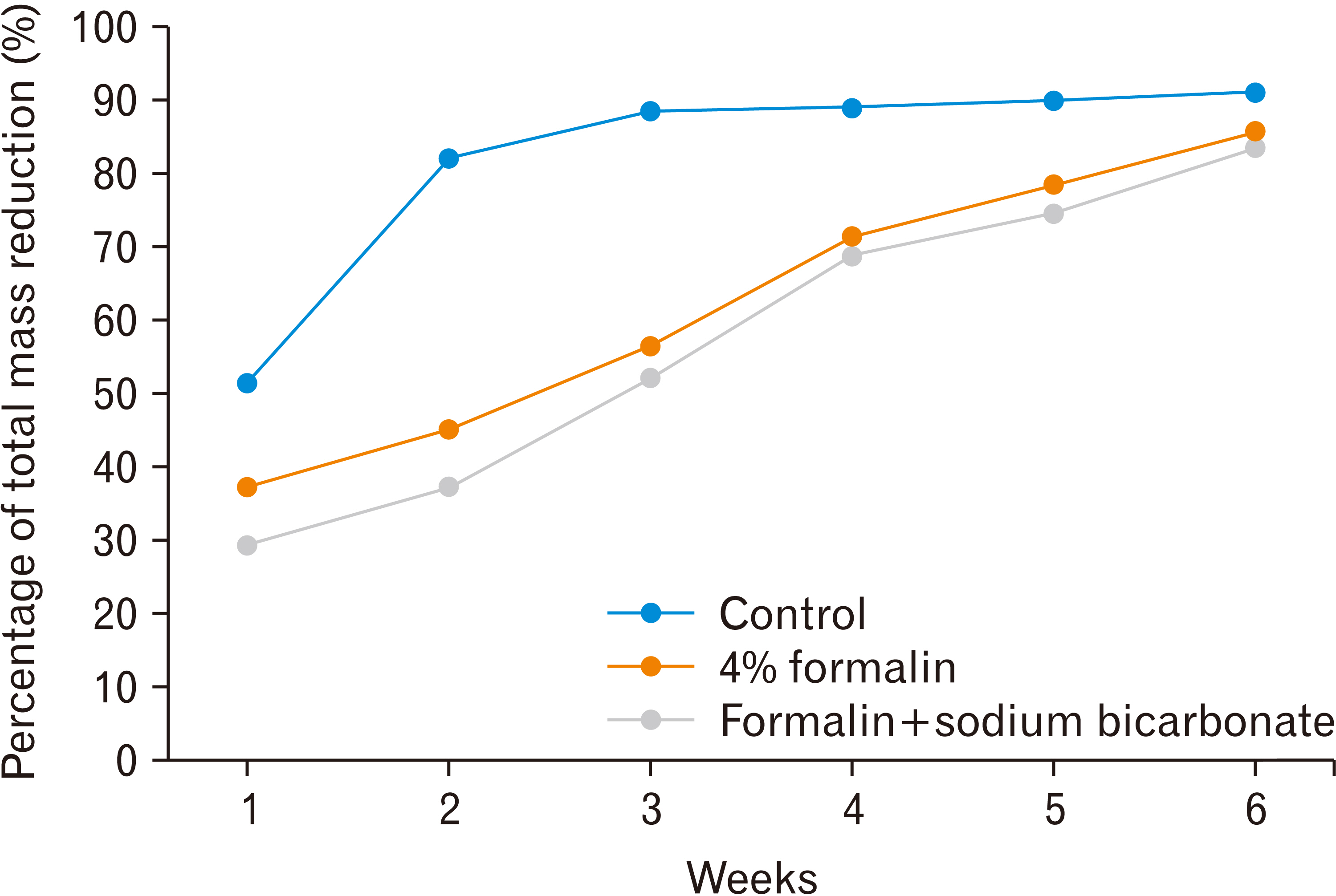Anat Cell Biol.
2022 Dec;55(4):459-466. 10.5115/acb.21.232.
The comparison of decrease in mice mass preserved with formalin 4% and neutralize with sodium bicarbonate
- Affiliations
-
- 1Undergraduate Program of Medical Education, Faculty of Medicine, Universitas Indonesia, Jakarta, Indonesia
- 2Department of Anatomy, Faculty of Medicine, Universitas Indonesia, Jakarta, Indonesia
- KMID: 2537465
- DOI: http://doi.org/10.5115/acb.21.232
Abstract
- Anatomy studies require cadavers to study the human body. Generally in Indonesia, the dead human body will be buried. This causes problems because the decomposition process of a cadaver that is preserved with formalin will be delayed and it causes environmental pollution. The toxicity of formalin can be reduced by neutralizing the formalin. This study aimed to compare the decrease of mice mass that were preserved with formalin then neutralized with sodium bicarbonate and those that were not neutralized. This study used 18 mice (Mus musculus) which were divided into 3 groups. They were the control group (not given preservative), group preserved with 4% formalin, and group preserved with 4% formalin then neutralized with sodium bicarbonate. All groups of mice were buried for 6 weeks. The changes in mass were assessed with an analysis of the percentage loss in mass. Based on the results of this study, the formalin group had a greater percentage of total mass reduction than the neutralize group. The formalin group had a higher decomposition rate than the neutralizing sodium bicarbonate group. The effectiveness of reducing the concentration of formalin is similar with neutralize group. Therefore, it can be concluded that 4% formalin is recommended for use to accelerate the occurrence of decay and decrease in mass.
Keyword
Figure
Reference
-
References
1. Brenner E. 2014; Human body preservation - old and new techniques. J Anat. 224:316–44. DOI: 10.1111/joa.12160. PMID: 24438435. PMCID: PMC3931544.2. Hayashi S, Naito M, Kawata S, Qu N, Hatayama N, Hirai S, Itoh M. 2016; History and future of human cadaver preservation for surgical training: from formalin to saturated salt solution method. Anat Sci Int. 91:1–7. DOI: 10.1007/s12565-015-0299-5. PMID: 26670696.3. Yogawisesa SC. 2018. Effect of 10% and 4% formalin solution in decomposition process of mice hindlimb. Universitas Indonesia;Jakarta: DOI: 10.1007/s12565-015-0299-5.4. Wijaya AN, Margiana R, Kusumaningtyas S, Furqonita D. 2021; Comparison of decomposition rate of hind limbs of preserved mice with ethanol-glycerin and formaldehyde of advanced fixative solution. Anat Cell Biol. 54:225–31. DOI: 10.5115/acb.20.314. PMID: 33767018. PMCID: PMC8225480.5. Elshaer NSM, Mahmoud MAE. 2017; Toxic effects of formalin-treated cadaver on medical students, staff members, and workers in the Alexandria Faculty of Medicine. Alex J Med. 53:337–43. DOI: 10.1016/j.ajme.2016.11.006.6. Musiał A, Gryglewski RW, Kielczewski S, Loukas M, Wajda J. 2016; Formalin use in anatomical and histological science in the 19th and 20th centuries. Folia Med Cracov. 56:31–40. PMID: 28275269.7. Liteplo R, Beauchamp R, Meek ME, Chénier R. 2002. Formaldehyde: concise international chemical assessment document 40. WHO;Geneva: p. 34–5.8. Andrushkevich TV, Popova GY, Danilevich EV, Zolotarskii IA, Nakrokhin VB, Nikoro TA, Stompel SI, Parmon VN. 2014; A new gas-phase method for formic acid production: tests on a pilot plant. Catal Ind. 6:17–24. DOI: 10.1134/S2070050414010024.9. 2022. Chemical properties of carboxylic acids: ionization and neutralization [Internet]. Chemistry Libretexts;California: Available from: https://chem.libretexts.org/Bookshelves/Introductory_Chemistry/Basics_of_General_Organic_and_Biological_Chemistry_(Ball_et_al.)/15%3A_Organic_Acids_and_Bases_and_Some_of_Their_Derivatives/15.04%3A_Chemical_Properties_of_Carboxylic_Acids-_Ionization_and_Neutralization. cited 2022 Aug 30.10. Senewiratne NL, Woodall A, Can AS. c2022. Sodium bicarbonate [Internet]. StatPearls Publishing;Treasure Island, FL: Available from: https://pubmed.ncbi.nlm.nih.gov/32644565/. cited 2022 Jun 4.11. Hu L, Adeyiga AA. 1997; Extraction of formic acid from sodium formate. Ind Eng Chem Res. 36:2375–9. DOI: 10.1021/ie9605443.12. 2018. Oct. 23. Sodium format: safety data sheet [Internet]. Breckland Scientific;Liverpool: Available from: https://www.brecklandscientific.co.uk/rennet-superwool/sodium-formate. cited 2020 Oct 20.13. Dutta S, Sengupta P. 2016; Men and mice: relating their ages. Life Sci. 152:244–8. DOI: 10.1016/j.lfs.2015.10.025. PMID: 26596563.14. Rydell-Törmänen K, Johnson JR. 2019; The applicability of mouse models to the study of human disease. Methods Mol Biol. 1940:3–22. DOI: 10.1007/978-1-4939-9086-3_1. PMID: 30788814. PMCID: PMC7121329.15. Burkholder T, Foltz C, Karlsson E, Linton CG, Smith JM. 2012; Health evaluation of experimental laboratory mice. Curr Protoc Mouse Biol. 2:145–65. DOI: 10.1002/9780470942390.mo110217. PMID: 22822473. PMCID: PMC3399545.16. Arifin WN, Zahiruddin WM. 2017; Sample size calculation in animal studies using resource equation approach. Malays J Med Sci. 24:101–5. DOI: 10.21315/mjms2017.24.5.11. PMID: 29386977. PMCID: PMC5772820.17. Surabian D. 2012. Preservation of buried human remains in soil. Natural Resources Conservation Service;Tolland: p. 1–14. DOI: 10.1016/j.lfs.2015.10.025.18. Hau T, Hamzah N, Lian H, Hamzah S. 2014; Decomposition process and post mortem changes: review. Sains Malays. 43:1873–82. DOI: 10.17576/jsm-2014-4312-08.19. Thavarajah R, Mudimbaimannar VK, Elizabeth J, Rao UK, Ranganathan K. 2012; Chemical and physical basics of routine formaldehyde fixation. J Oral Maxillofac Pathol. 16:400–5. DOI: 10.4103/0973-029X.102496. PMID: 23248474. PMCID: PMC3519217.20. TURI. 2014. Health and Environment: Formaldehyde Fact Sheet [Internet]. TURI;Lowell: Available from: http://www.turi.org/TURI_Publications/TURI_Chemical_Fact_Sheets/Formaldehyde_Fact_Sheet/Formaldehyde_Facts/Health_and_Environment. cited 2020 Oct 20.21. Pozzo AD, Moricone R, Tugnoli A, Cozzani V. 2019; Experimental investigation of the reactivity of sodium bicarbonate toward hydrogen chloride and sulfur dioxide at low temperatures. Ind Eng Chem Res. 58:6316–24. DOI: 10.1021/acs.iecr.9b00610.22. Ajileye AB, Esan EO, Adeyemi O. 2018; Human embalming techniques: a review. Am J Biomed Sci. 10:82–95. DOI: 10.5099/aj180200082.23. Rengasamy P. 2016; Soil chemistry factors confounding crop salinity tolerance: a review. Agronomy. 6:53. DOI: 10.3390/agronomy6040053.24. Jin Q, Kirk MF. 2018; pH as a primary control in environmental microbiology: 1. thermodynamic perspective. Front Environ Sci. 6:1–13. DOI: 10.3389/fenvs.2018.00021.
- Full Text Links
- Actions
-
Cited
- CITED
-
- Close
- Share
- Similar articles
-
- Comparison of decomposition rate of hind limbs of preserved mice with ethanol-glycerin and formaldehyde of advanced fixative solution
- Role of Intravenous Sodium Bicarbonate and Oral N-acetylcysteine in Radiocontrast-Induced Nephropathy
- A Study for Reducing Pain from Injection of Lidocaine Hydrochloride
- Appropriate Dosage of 8.4% Sodium Bicarbonate for Preventing Injection Pain of Rocuronium during Anesthetic Induction
- Effect of Sodium Bicarbonate or Lidocaine Mixed with Rocuronium on Withdrawal Movement during Rocuronium Injection



